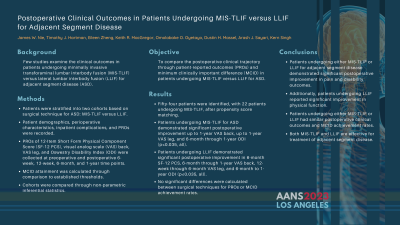Postoperative Clinical Outcomes in Patients Undergoing MIS-TLIF versus LLIF for Adjacent Segment Disease
Friday, April 21, 2023


James W. Nie, BS (he/him/his)
Medical Student
University of Illinois College of Medicine
Chicago, Illinois, United States
ePoster Presenter(s)
Introduction: Few studies examine the clinical outcomes in patients undergoing minimally invasive transforaminal lumbar interbody fusion (MIS-TLIF) versus lateral lumbar interbody fusion (LLIF) for adjacent segment disease (ASD). This study aims to compare the postoperative clinical trajectory through patient-reported outcome measures (PROMs) and minimum clinically important difference (MCID) in patients undergoing MIS-TLIF versus LLIF for ASD.
Methods: Patients were stratified into two cohorts based on surgical technique for ASD: MIS-TLIF versus LLIF. Patient demographics, perioperative characteristics, inpatient complications, and PROMs were recorded. PROMs of 12-Item Short Form Physical Component Score (SF-12 PCS), visual analog scale (VAS) back, VAS leg, and Oswestry Disability Index (ODI) were collected at preoperative and postoperative 6-week, 12-week, 6-month, and 1-year time points. MCID attainment was calculated through comparison to established thresholds. Cohorts were compared through non-parametric inferential statistics.
Results: Fifty-four patients were identified, with 22 patients undergoing MIS-TLIF, after propensity score matching. Patients undergoing MIS-TLIF for ASD demonstrated significant postoperative improvement up to 1-year VAS back, up to 1-year VAS leg, and 6-month through 1-year ODI (p≤0.035, all). Patients undergoing LLIF demonstrated significant postoperative improvement in 6-month SF-12 PCS, 6-month through 1-year VAS back, 12-week through 6-month VAS leg, and 6-month to 1-year ODI (p≤0.035, all). No significant differences were calculated between surgical techniques for PROMs or MCID achievement rates.
Conclusion : Patients undergoing either MIS-TLIF or LLIF for adjacent segment disease demonstrated significant postoperative improvement in pain and disability outcomes. Additionally, patients undergoing LLIF reported significant improvement in physical function. Patients undergoing either MIS-TLIF or LLIF had similar postoperative clinical outcomes and MCID achievement rates. Both MIS-TLIF and LLIF are effective for treatment of adjacent segment disease.
Methods: Patients were stratified into two cohorts based on surgical technique for ASD: MIS-TLIF versus LLIF. Patient demographics, perioperative characteristics, inpatient complications, and PROMs were recorded. PROMs of 12-Item Short Form Physical Component Score (SF-12 PCS), visual analog scale (VAS) back, VAS leg, and Oswestry Disability Index (ODI) were collected at preoperative and postoperative 6-week, 12-week, 6-month, and 1-year time points. MCID attainment was calculated through comparison to established thresholds. Cohorts were compared through non-parametric inferential statistics.
Results: Fifty-four patients were identified, with 22 patients undergoing MIS-TLIF, after propensity score matching. Patients undergoing MIS-TLIF for ASD demonstrated significant postoperative improvement up to 1-year VAS back, up to 1-year VAS leg, and 6-month through 1-year ODI (p≤0.035, all). Patients undergoing LLIF demonstrated significant postoperative improvement in 6-month SF-12 PCS, 6-month through 1-year VAS back, 12-week through 6-month VAS leg, and 6-month to 1-year ODI (p≤0.035, all). No significant differences were calculated between surgical techniques for PROMs or MCID achievement rates.
Conclusion : Patients undergoing either MIS-TLIF or LLIF for adjacent segment disease demonstrated significant postoperative improvement in pain and disability outcomes. Additionally, patients undergoing LLIF reported significant improvement in physical function. Patients undergoing either MIS-TLIF or LLIF had similar postoperative clinical outcomes and MCID achievement rates. Both MIS-TLIF and LLIF are effective for treatment of adjacent segment disease.
